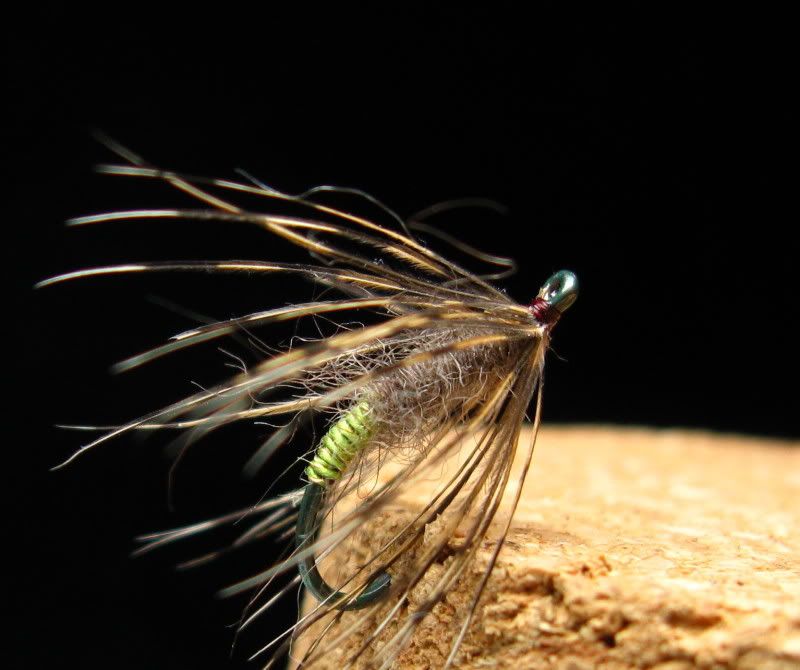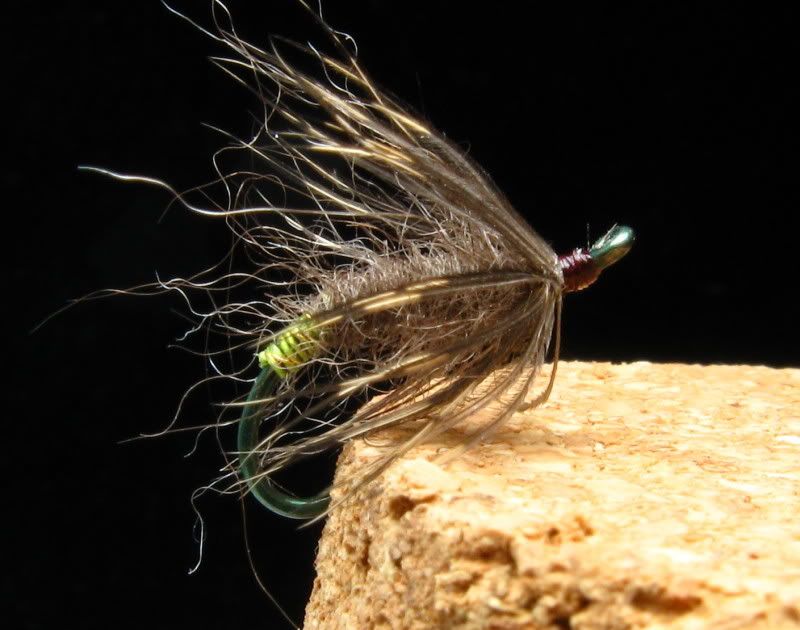Half Stone Nymph
Moderators: William Anderson, letumgo
Re: Half Stone Nymph
According to one Google source, a Half Stone was roughly equivalent to seven pounds. So, then, perhaps this fly was intended only for catching seven-pound trout? 
Re: Half Stone Nymph


These are a couple tied as West Country Wet/Dry flies.
Half Stone
Hook: 0 or (a)16 TMC 101. (b) 12,14 Daiichi 1640.
Silk: Yellow.
Body: Two-thirds yellow silk, one-third mole fur.
Hackle: (a)Medium blue dun cock. (b) Honey dun cock.
Re: Half Stone Nymph
I am going to be pedantic again, a half stone was exactly seven pounds,
and still is.
and still is.
-
Mike Connor
Re: Half Stone Nymph
The "Half-Stone" also called "The Devon Half-Stone", is a very old traditional fly from the Devon/Debyshire area. The pattern has been used for a very long time and has been quite consistent over that time. It became widely known because Halford created a "variant" of it as a dry fly pattern, his dressing is;
Hook : 12 - 14
Thread :
Tail : Blue dun cock hackle fibres
Body, rear half : Yellow floss silk
Body, front half : Blue fur, Mole.
Hackle : Blue dun cock hackle palmered over 'front half' of body
He also gave it as a grayling pattern which was probably the original;
Nr. 58 on this plate
http://www.archive.org/stream/floatingf ... 0/mode/2up
http://www.archive.org/stream/floatingf ... 5/mode/2up
The original was a wet fly used a lot in Derbyshire and environs. I have a few references to it if anybody is interested.
Here is a video of a modern dressing;
http://www.youtube.com/watch?v=4iCOeClz ... r_embedded
TL
MC
Hook : 12 - 14
Thread :
Tail : Blue dun cock hackle fibres
Body, rear half : Yellow floss silk
Body, front half : Blue fur, Mole.
Hackle : Blue dun cock hackle palmered over 'front half' of body
He also gave it as a grayling pattern which was probably the original;
Nr. 58 on this plate
http://www.archive.org/stream/floatingf ... 0/mode/2up
http://www.archive.org/stream/floatingf ... 5/mode/2up
The original was a wet fly used a lot in Derbyshire and environs. I have a few references to it if anybody is interested.
Here is a video of a modern dressing;
http://www.youtube.com/watch?v=4iCOeClz ... r_embedded
TL
MC
Re: Half Stone Nymph
Donald and Mike,
Thanks for the additional history on the Half Stone. Roger Fogg covers the half-stone in his book, WET-FLY TYING AND FISHING, page 132.
Here is another attempt, this time with silver wire, and a darker dun hackle.

Thanks for the additional history on the Half Stone. Roger Fogg covers the half-stone in his book, WET-FLY TYING AND FISHING, page 132.
Here is another attempt, this time with silver wire, and a darker dun hackle.

-
CreationBear
- Posts: 1156
- Joined: Sun Jun 20, 2010 6:35 pm
Re: Half Stone Nymph
Ha, great minds indeed: call this one a "Skunk Cabbage" I guess:

I'm with Dubbn that most of these would come closest to diving, ovipositing caddis adults, not just because of "anatomy," but because I think it would be hard to fish a true flymph in a manner that would imitate a stonefly nymph. This I suppose is more "caddis-y"

but to be honest, I sort of like the first one better...just a two-toned blur, anyways, in my high gradient streams.

I'm with Dubbn that most of these would come closest to diving, ovipositing caddis adults, not just because of "anatomy," but because I think it would be hard to fish a true flymph in a manner that would imitate a stonefly nymph. This I suppose is more "caddis-y"

but to be honest, I sort of like the first one better...just a two-toned blur, anyways, in my high gradient streams.
- Soft-hackle
- Site Admin
- Posts: 1874
- Joined: Sat Feb 21, 2009 10:23 am
- Location: Wellsville, NY
Re: Half Stone Nymph
Great pattern.
Mark
Mark
"I have the highest respect for the skilled wet-fly fisherman, as he has mastered an art of very great difficulty.” Edward R. Hewitt
http://www.libstudio.com/FS&S
http://www.libstudio.com/FS&S
Re: Half Stone Nymph
CB, Beautiful photographs, and patterns. You may have missed the explanation here from Donald and Mike that the traditional Devon Half Stone was not a reference to the stonefly at all. However, Roger Fogg says that it was a generic attractor designed for fast water, like yours, where the yellow body would scream "Eat me!" as it shot by in a blur.
This two-tone body/thorax design is similar to the Tups Nymph that was a big favorite of Leisenring and Hidy. But the Half-Stone seems to have been neglected by modern fly tiers.
This two-tone body/thorax design is similar to the Tups Nymph that was a big favorite of Leisenring and Hidy. But the Half-Stone seems to have been neglected by modern fly tiers.
-
CreationBear
- Posts: 1156
- Joined: Sun Jun 20, 2010 6:35 pm
Re: Half Stone Nymph
I love those kinds of flies.However, Roger Fogg says that it was a generic attractor designed for fast water, like yours, where the yellow body would scream "Eat me!" as it shot by in a blur.
Re: Half Stone Nymph
To Gingerdun and all others contributing,
I found something interesting about the Half Stone Nymph in Ken Robsons great work "The Essential G.E.M. Skues" on page 85. The orig. writings were from Skues book "The Way of a Trout with a Fly. In the chapter of Ken Robsons book entitled "Skues and the Nymph", Skues is explaining how he developed a couple (eventually, there were many more) of basic nymphs for fishing the Itchen and other chalkstreams of the South of England. He then travels along to "one of the oldest nymph patterns,the Half-stone." Here is some interesting writing from Skues pertaining to this pattern in this thread.
"In shape of body the nymph may be easily imitated. Colour is difficult to set down with precision in writing so that the fly dresser can reproduce it with certainty, and the best line of attack seems to me to be suggested by one of the oldest nymph patterns, the Half-stone. Here one has a bright, almost water-coloured , outer hackle, almost invisible to a fish looking up, and a nymph-shaped body well displayed with the thorax of mole's fur spun on yellow silk, and the yellow floss lower half of the body which goes green in the water.
For colour, the angler who desires exact representation in that respect would have to go to the living nymph. A dip of a muslin net into a clump of river weed would produce a large variety of nymphs in all colours, from pale yellow to darkest olive, and even to carrot color."
This text, in comparison with what everyone has posted as far as pictures of the older patterns and the newer ones, seems to be as relavent today as it was back then. It appears that in Gingerduns photo's there was a great attempt to immitate the body colors of different nymphs as Leisenring and Hidy encountered as they travelled from one place (watershed or river or stream) to another.
Mayfly vs. Caddis nymph? Skues was refering to Mayfly nymphs in his writings in this part of Ken Robsons book. The pictures presented by Gingerdun seem more Caddis-like. Gee, can't we nowadays with all the specialty hooks avail. with so many styles,adjust our tyings to fit the need? Our forefathers gave us a great starting point. Let's build upon it!
Dougden (Gingerdun and Creationbear, your patterns are excellent!)
I found something interesting about the Half Stone Nymph in Ken Robsons great work "The Essential G.E.M. Skues" on page 85. The orig. writings were from Skues book "The Way of a Trout with a Fly. In the chapter of Ken Robsons book entitled "Skues and the Nymph", Skues is explaining how he developed a couple (eventually, there were many more) of basic nymphs for fishing the Itchen and other chalkstreams of the South of England. He then travels along to "one of the oldest nymph patterns,the Half-stone." Here is some interesting writing from Skues pertaining to this pattern in this thread.
"In shape of body the nymph may be easily imitated. Colour is difficult to set down with precision in writing so that the fly dresser can reproduce it with certainty, and the best line of attack seems to me to be suggested by one of the oldest nymph patterns, the Half-stone. Here one has a bright, almost water-coloured , outer hackle, almost invisible to a fish looking up, and a nymph-shaped body well displayed with the thorax of mole's fur spun on yellow silk, and the yellow floss lower half of the body which goes green in the water.
For colour, the angler who desires exact representation in that respect would have to go to the living nymph. A dip of a muslin net into a clump of river weed would produce a large variety of nymphs in all colours, from pale yellow to darkest olive, and even to carrot color."
This text, in comparison with what everyone has posted as far as pictures of the older patterns and the newer ones, seems to be as relavent today as it was back then. It appears that in Gingerduns photo's there was a great attempt to immitate the body colors of different nymphs as Leisenring and Hidy encountered as they travelled from one place (watershed or river or stream) to another.
Mayfly vs. Caddis nymph? Skues was refering to Mayfly nymphs in his writings in this part of Ken Robsons book. The pictures presented by Gingerdun seem more Caddis-like. Gee, can't we nowadays with all the specialty hooks avail. with so many styles,adjust our tyings to fit the need? Our forefathers gave us a great starting point. Let's build upon it!
Dougden (Gingerdun and Creationbear, your patterns are excellent!)
Fish when you can, not when you should! Anything short of this is just a disaster.
